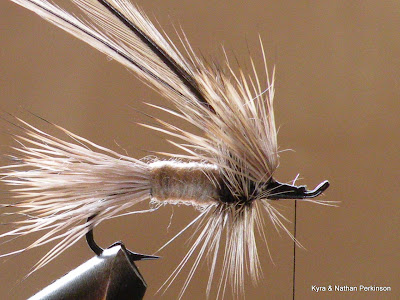 |
| A Gray Wulff dry fly, salmon-size. |
This particular article ended with a short story about fly-fishing legend Lee Wulff, who went to Scotland in 1962 to investigate Spey fishing for himself. Upon learning about the Spey techniques from Jock Scott, Wulff produced his trusty six-foot salmon rod, tied on a dry fly and caught more fish than Scott. My first thought was, "Dear God! Jock Scott was still alive in 1962?" A little research revealed that the original Jock Scott, for whom the famous salmon fly was named, was born around 1817. It seems that the "Jock Scott" in question was actually Donald Rudd, who wrote Greased Line Fishing for Salmon under the pen name Jock Scott. Regardless, the fact remains that Lee Wulff out-fished either world-renowned author and Spey angler Donald Rudd, or an amazingly spry 150 year-old Jock Scott. Travelling to Scotland and catching more fish than a modern legend, eschewing the local fishing standard in favor of more familiar equipment and technique, stands as a great feat that should inspire anglers around the world.
The next time you read an article about the latest fly-fishing technique or the newest piece of gear, try to remember the lesson that Lee Wulff taught us in Scotland. Learn to use your equipment to its maximum potential. As you gain confidence, your skill in using that equipment will far surpass any advantage you would gain from a new rod or the latest hundred-dollar fly line.
Because today's topic centered around Lee Wulff, I would like to share with you how I tie Wulff-style dry flies, salmon sized, like the one pictured at the top of the article.
Gray Wulff
Hook: Up-eye salmon hook, size 8
Thread: Black Danville Flymaster 6/0
Wings: Natural deer hair
Tail: Natural deer hair
Body: Superfine dry-fly dubbing, tan
Hackle: Gray badger
 |
| You may now apply dubbing and wrap the body. |
 |
| We will use four hackles to keep this dry fly floating. Push the wings forward slightly and tie in two hackles at the front of the body. Wrap them forward and tie off behind the wings. |
 |
| You may now push the wings back slightly, tie in two more hackles and wrap to the front. Tie off the hackles, make a neat head, whip finish and cement. |
 |
| The finished fly has loads of deer hair and big, bushy hackle. |
Big dry flies like this one are popular among salmon and steelhead anglers looking to lure fish to the surface. If you are not fortunate enough to live where these big fish haunt the rivers, do not despair. A salmon-sized Wulff fly like this is great for your favorite largemouth pond or smallmouth stream as well.


No comments:
Post a Comment